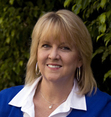Ora Smith's Blog
September 15, 2025
Historical Novel Society Posted My Article in Their September Newsletter
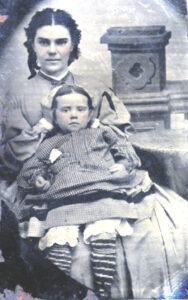
Have YOU ever wanted to use your ancestors as characters in a short story or novel? The Historical Novel Society posted my article about doing just that. Check out Look No Further Than Those in Your Family to find out what it entails. It’s not as hard as you think. I even give examples of authors who have done it.
Here’s a list of authors who have used their ancestors as characters in books you’ve probably heard of or read:
Where the Lost Wander by Amy Harmon
These Is My Words by Nancy E. Turner
Hotel on the Corner of Bitter and Sweet by Jamie Ford
Cold Sassy Tree by Olive Ann Burns
Sarah, Plain and Tall by Patricia MacLachlan
Galway Bay by Mary Pat Kelly
Hattie Big Sky by Kirby Larson
Condemn Me Not: Accused of Witchcraft by Heather B. Moore
A Pawn for a King by Sarah Hinze
Daughter of Anne-Hoeck by Carol Pratt Bradley
Cane River by Lalita Tademy
The Hummingbird’s Daughter by Luis Alberto Urrea
The Joy Luck Club by Amy Tan
The Last Kingdom by Bernard Cornwell
The Glass-Blowers by Daphne du Maurier
East of Eden by John Steinbeck
To Kill a Mockingbird by Harper Lee
Little Women by Louisa May Alcott
David Copperfield by Charles Dickens
The Scarlet Letter by Nathaniel Hawthorne
The House of the Seven Gables by Nathaniel Hawthorne
Roots by Alex Haley
Wuthering Heights by Emily Brontë
On Gold Mountain by Lisa See
If you’re thinking of writing about an ancestor still living, see my blog: How To Interview Your Elderly Family Members

Happy writing!
June 12, 2025
A New Outdoor Musical Pageant about John Lothropp
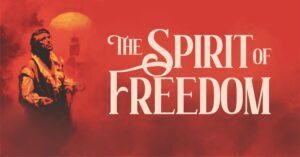
I helped write the narration for an upcoming Christian pageant. As many of you know, I wrote a novel about John Lothropp (titled The Pulse of His Soul) and extensively studied his life. I hope others can help us get this to the “stage” (Sanpete County Fairgrounds) by summer 2026. Its main themes are Family, Faith, and Freedom and although debuting in Utah, it is non-denominational in content. You will love it!
The pageant will include live scenes from The Pulse of His Soul.It was featured on the news! Check it out.
The Spirit of Freedom pageant has such an important message! Please consider donating for its production.
Thank you! Here’s to it’s success!!!
For more information: The Spirit of Freedom Pageant website.

May 16, 2025
Heritage Cookbook on Kickstarter – Can you Help with Development?

Step into the heart of a heritage kitchen where love, flavor, and tradition come together.
Keep the Pie Bird Singing is more than a cookbook—it is a unique journey back to a time when meals weren’t just about food, but about family, laughter, and love around the table. Packed with tried-and-true recipes passed down through generations because they were that good! This cookbook invites you to savor the flavors of history as you feast your eyes on photographs of mouthwatering dishes and learn about the charming, timeworn tools our ancestors once used to prepare them.

Discover heartwarming stories, fascinating tidbits of food history, and a glimpse into a simpler life when kitchens were the heart of the home. The pages will stir your senses, spark your memories, and remind you of the joy of gathering, sharing, and savoring every moment with those you love.
I’m hoping you might be interested in a pre-order of my cookbook Keep the Pie Bird Singing. The pre-order gives you an opportunity to get it at a discounted price, and also get rewards associated with it. See the Kickstarter Campaign here.
As I’ve mentioned in other blogs, I’ve explored forty-eight states and four countries in search of my roots. I’m the author of six novels and two novellas I call heritage fiction—stories inspired by my ancestors whose lives are worth remembering. Along the way, I’ve collected heirloom recipes, vintage kitchen tools, and food histories of those who came before me. On the road, I’m always on the lookout for that tucked-away, family café serving comfort food. I never seem to forget when I’ve had a delicious meal or met incredible people. At home, I garden for fresh ingredients that nourish body and soul, and I dream of helping others reconnect with their own roots through family food traditions and teaching them how to research.

If you want to play a direct role in bringing a beautiful, meaningful cookbook to life, here’s the link again to learn more (or donate your own ancestors’ recipe!). Thank you so much!

UPDATE 6/9/25 – Sadly, the Kickstarter campaign was not funded. Stay tuned for what will happen next with this exceptional and unique cookbook! 
May 3, 2025
February 28, 2025
Dreams About Ancestors
Have you had dreams related to your ancestors?
I have. They were unusual enough to know they were important. The most important ones were repeated throughout the night until I had them memorized.
I believe dreams can be a valid way to receive valuable information. Dreams may feel more significant when an ancestor delivers the message. Why an ancestor? Because they care about us, I believe.
Years ago, I read a series of books by Henry “Hank” Z. Jones called Psychic Roots: Serendipity and Intuition in Genealogy. I loved those books full of individual’s stories because if you’ve done genealogy long enough, you know weird and unexplainable events can happen that help you find your ancestors—as if they want to be found. Mr. Jones would sometimes share stories of someone who’d had a dream that helped him/her get past a brick wall in research.
Ancestors may also come in dreams to comfort us with hard trials. Many cultures look to their ancestors for answers. Native Americans and Africans regard dreams as sacred if an ancestor visits during the dream.
When researching my family, I once reached out to a woman who was distantly related but a stranger to me. We visited on the phone about a common ancestor who in her loneliness as a child came to her in dreams to console her. She told the stories in such a reverent and respectful manner that I couldn’t help but believe her.

I’ve read stories of loved ones having passed away but then came to a family member who grieved their loss and were comforted during a dream. The deceased can give healing and help with processing tough experiences and perhaps give a gift of hope.
Some people believe dreams can be revelatory—maybe offering us information we’ll need in the future. Which makes me think of Biblical stories like Pharoah’s dreams that needed to be interpreted by Joseph, or Pilate’s wife’s dream about Jesus’ innocence. Regular people (not just “righteous” people like Joseph who was told in a dream to flee to Egypt to keep Jesus safe) can receive important messages through dreams.
Ancestral dreams can be given to those with spiritual gifts, but also to those who don’t have such endowments.
I know there are those who are skeptic about such things, but I’ll go on record as saying I believe dreams can be a source of comfort and help. Call me crazy if you’d like. It’s hard to prove “spiritual” experiences regarding the love a dead person might have for me, nor do I want to try to prove anything. You either believe or you don’t, I suppose.
Why I’m writing about this today is because last week I gave a presentation to a group of people who wanted encouragement with searching their family trees. At the end of my sharing some personal stories, I asked the audience if they had any questions. A woman asked if I’d ever had a dream that fed me information about an ancestor. I’ve had several, but the one I shared that night happened about fifteen years ago. I was in the thick of researching my Mattocks family of North Carolina and I kept finding clues that they were from Maryland originally, but no substantial records could be found to link my family to the Maryland Mattocks’s.
One night, I had a dream throughout the entire night. It repeated itself over and over again—the exact same dream. In the dream I was looking out at a swath of land, and I was told by an unseen person how important the land was to him. The importance of the land was drummed into my head as was this view of the land. When I awoke, I knew the dream was important, so I started delving into land records. I didn’t find anything of great value but never forgot the dream. Fast forward three years later, I was in the countryside of Somerset County, Maryland where I suspected my ancestors were from. I had rented a car and drove out to an old house to question the owners if they knew if a Mattocks had built their home, or if they knew of any old Mattocks cemeteries in the vicinity.
When I pulled up to the house a very vicious dog on a chain barked and snarled nonstop, pulling at his chain, and guarding the front porch and door. I suspected that if I got out of the car, he would attack me. Consequently, I didn’t get out of the car. Instead, I waited to see if anyone would come out of the house and quiet the dog and then visit with me. No one did, so I turned the car around to leave. Exiting the dirt driveway, there in front of me was the land I was shown in the dream over and over again. I suddenly understood that not only was I on the “important” land that was once my ancestors, but also that I was shown it so many times throughout the night so that I would recognize it three years later.
I still can’t document that my North Carolina ancestors connect to the Maryland Mattocks family, but I know they do.
Through my study, and people sharing their stories with me, and through my own dreams, this following list is what I believe ancestors can do for us in dreams:
Help us make important decisionsHelp with finding our relativesTeach us of our pastGive a new perspective we hadn’t thought ofPrepare us for something that is to comeIn a humble way, teach us a lesson that will benefit our livesGive peace of mind, hope, and healingIf you have an important dream, may I give advice to write the dream down as soon as you awaken. There are details you may lose during the day or weeks or months. When preparing for this post, I read a 2015 dream I’d written down immediately. I’d forgotten so many of the details and was glad I’d recorded them.
I honestly believe dreams that include an ancestor are meant to bless us and possibly other family members. So to you I say, Sweet Dreams!
January 27, 2025
Understanding Ancestors Who Did Bad Things
I grew up in California and still remember sitting in 5th grade class learning about the Civil War. I can’t recall all that was taught, but it was the first time I remember learning about slavery. I was appalled with the concept and glad when the teacher told us the South lost, and slavery was abolished.
At home that evening, I told my mother about what I’d learned and passionately said something along the lines of, “I can’t believe people would have slaves! How could they?”
She stopped preparing dinner and looked at me. “It may not have been exactly as it seems. I guess you don’t realize your ancestors fought for the South.”
I was stunned and actually had a physical reaction of revulsion. I wanted to deny it—hide it. How could “those people” be my people?

As disturbed as I was, I was too immature to research and try and make sense of slave owners or those who populated the south in the 1860s, but I did always carry a confused feeling of wrongdoing on my ancestors’ part.
George Norlin is famous for the quote inspired by the writings of Cicero: “Who knows only his own generation remains always a child.” This quote is engraved into stone on the library entrance at the University of Colorado. Why a library? Because it’s where we research, learn, and discover history—and where we can start to learn to understand people.
It’s wonderful if we have ancestors who sacrificed and made our world a better place, but sometimes our ancestors don’t fall into this category, and it might keep us from understanding them. Or maybe pain exists because we’re angry or bitter at an ancestor for negligence or abuse. For instance, when writing my master’s thesis, I learned that my family had a generational chain of indifference because of alcoholism—not such an uncommon thing, but it caused bad relationships in my present-day family as well.
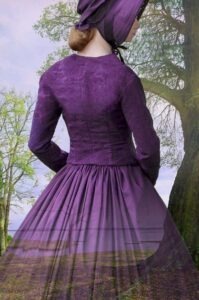
I can take it further and say, being 36% British (says my DNA), I am ashamed of my English ancestors who didn’t help my Irish (21%) ancestors during The Great Famine. It’s history and can’t be changed. I can claim it, but then what? Hopefully, I say, “I don’t want to be like them.” But with me, I’m wanting to understand why they would do such things.
The “why” is where greater understanding takes place. And so, I research and I learn and I better comprehend my ancestors actions without making excuses for them. I try and see it from their point of view.
We can gain positive virtues while learning about our ancestors.
Often, learning of their history and culture can help us understand why they did what they did and allow us to put hurt, anger, shame, or denial aside.
Can studying your ancestors help you put hurt aside? They are dead, so how do we make personal amends for their immoral ideas and actions? And should a black person hate me for what my slave owning ancestor did?
Empathy is the ability to understand and share the feelings of another—to identify with their experiences or thoughts. To truly empathize, you must understand a person. To find that understanding with ancestors, you must research the past.
I had to find healing from deep wounds, especially those mired in racism. I found that a basic sense of humanity can enable change. It is counterproductive to say I am the face of my slave-holding ancestors, or those who mistreated the Irish. I have chosen to be free of my ancestors’ belief systems and the decisions they made, and I will not pass them onto my children.
Another way to heal would be to talk about your ancestors with family members and explore ways to move forward. Think about things in different ways by examining others’ beliefs. If we open our hearts to our ancestors as humans who have made mistakes, we can heal ourselves, families, and our nation of wrongs made.
The past matters and whether we realize it or not, our ancestors have been involved in our lives. But as L. Thomas Holdcroft said, “The past is a guidepost, not a hitching post.”
When I am feeling gratitude for those who went before me, I feel more connected to my community. I read an article in the Huffington Post long ago and it still sticks with me. I put the link below. It’s about the health benefits of feeling gratitude. Gratitude brings forward positive emotions and boosts our well-being, strengthening relationships (past and present). The article is worth the read.
My book club read Alexander Hamilton by Ron Chernow. During our discussion of the book, many of us voiced surprise at how many of our revered Founding Fathers had some pretty serious personality flaws and engaged in immoral acts like cheating on their spouses. One book club member made the comment, “Imperfect people can still accomplish great things.” And aren’t we all imperfect? There are many levels of perception that help us develop understanding and compassion.
When I was discussing my 5th grade experience with a friend, she suggested I do a genogram. A genogram is a family tree that graphs data on hereditary patterns (medical and psychological), and other factors that play into relationships to help you find the events that affected your family. I am in the process of gathering this information and look forward to learning more about my ancestors. If you’ve done a genogram yourself, I’d love to hear what you’ve learned. Please leave a comment that would be beneficial to this discussion regarding learning about (and possibly forgiving) ancestors.
January 26, 2025
How to Organize Your Family Records on Your Computer
Keeping organized records will be a great benefit as you research your ancestors. I use family history software for my family tree records. For my old photographs and documents, I scan and keep them in media files within folders labeled with surnames they pertain to. All surname folders are within an overall folder called “Family History.” I also attach some photos and documents to family members in my family tree software. As is true of audio and video clips of ancestors.
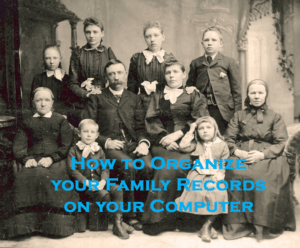
Family History Software
Family tree software will not only help with the organization but will give you a database where you can keep notes and document sources. Why not just use ancestry.com, you may ask? Cost, for one. Here’s a list of why I like my own family tree software:
Keeping records of living people. (These should be hidden on ancestry.com except to the contributor of the information)Unproven individuals you are still researching.Families you may be in the process of working on documenting, but not yet willing to share publiclyPrivate information or personal notesGenetic medical conditions documentationDNA genealogy you feel is privateAdvanced searches in your database. For example, you can select names to research in a specific place or find all people in your database buried in a certain cemetery.Multiple databases can be kept in your software. For example, a Personal Family Tree, Spouses Family Tree, Possible Related Families, Shared Family Trees from someone else (to be verified), and Adopted vs Biological Family TreesYou can attach photographs, sound clips, video clips, and documents. (You can do some of these on ancestry.com)Research Documentation Capabilities (verified and unverified records)Notes Feature (has more space than ancestry.com)Printing Options – You can create and print many different reports, including research questions. You can print pedigrees, family group records, and many other charts and reports to share at a family reunion, or with other researchers. These can be shared electronically or on paper.None of these reasons need stop you from also having your tree on ancestry.com. I use both. By using ancestry.com, I can find relatives more readily and also share my relatives’ records with others.
What Family Tree Software is the Best?
There are many family history software options available. Each has its particular pros and cons and I would suggest investigating each of them before making a purchase. For instance, not all software companies sell for both Mac and WindowsPC, or for tablets, or have apps for SmartPhones.
The 5 most popular family tree software:
Family Tree MakerRoots MagicLegacy Family TreeMyHeritage Family Tree BuilderReunion for MacFree Family History Software
Ancestral Quest and RootsMagic (and possibly others) have a free basic version you can download, which is a great way to discover if its functions are what you’re looking for.
I’m not trying to sell you on any of them. The best choice for you often depends on personal preference and needs.
Collaboration Features (some software)
You can work on the same files with other researchers or family members, or share between your different devices (i.e., laptop and tablet). Changes made by one collaborator (say, your sister) can be seen by other collaborators (perhaps yourself). You can save your database to a server or cloud with some software products, which ensures not losing your information in the event of a hard drive failure, loss of computer, etc.
Using a GEDCOM (.ged) File
All family history software, whether Mac or PC, can share amongst each other with a type of file that is called a GEDCOM (.ged stands for Genealogical Exchange Data)
Personal software enables you to choose what, how, and when to share by creating and sharing GEDCOM files.
To create a .ged, you will use your Export functions. To add a .ged into your database, you will use your Import functions. Follow your software guidelines to Import/Export a .ged
You can share your database, or part of your database, by creating a .ged.
Share by:
.ged on Flash/Thumb DriveEmail .ged attachmentPersonal BlogGoogle DriveDropboxwebsite: ancestry.com (use .ged to create initial Family Tree)website: most any family tree sites that accept DNA reportsI hope this information helps you with organizing your family history! If you have an questions, just leave a comment and I’ll try and answer.
December 17, 2024
The Spiritual Implications of AI: Are Creatives Discounting God?

Years ago, I was driving during the rush of the Christmas season listening to “Handel’s Hallelujah Chorus.” A spiritual feeling of truth moved within me, telling me God inspired the work. Tears came to my eyes, and I was grateful for such a revelation and could feel the divine power in the music. After that, I investigated Handel and found that moments after he wrote the chorus movement, a servant came into the room and startled him. “I did think I did see all Heaven before me, and the great God Himself,” Handel told the man. Handel was also known to have said multiple times up until his old age that the music he composed did not come from him “but from Heaven.”
When we study the lives of other past great creators, we often find artists, writers, musicians, and others crediting God for their inspiration. Michelangelo authored a poem expressing his belief that God would grant him the ability to create a pleasing image of Christ. He gave forethought to what it meant to serve God with his gifts. Bach called to God from the onset of composing. When he started with a blank page, he frequently initialed the paper with the markings JJ (Jesu juva), meaning “Jesus help me.” Of Mozart’s compositions he once said, “I prayed to God for His mercy that all might go well, to His greater glory, and the symphony began.” The author Flannery O’Connor is a well-known example of a famous writer who prayed before writing. She expressed her reliance on God for inspiration and guidance. Not all these creatives professed to strong spiritual faith regarding their works, yet they acknowledged their inspiration came from God.
At a writers’ conference, I heard someone expressing her fear that creative writers will use AI instead of praying for inspiration and that literature will become dumbed-down with nothing fresh and inspiring. I don’t believe it will go to that extreme, but I do believe her concerns might be true in some cases. After all, how will one know what creative genius was missed if they asked AI instead of God? How far is humanity stepping away from God because of AI?
As an author who writes historical fiction based on true stories, I pray before I start each chapter. I write about real people and want to respect them as I tell their stories. In many instances, only God can tell me the right answers because there’s no way I could know otherwise. I also want to be at top form with creative prose and believe God can help with inspiration. Consequently, I have experienced information coming to me that I wouldn’t have known without the help of an all-knowing higher being.
I took a class in AI for writers and was greatly disappointed in the outcome. Although I learned how to make fantastic prompts for AI generators, the results for creative writing were lame and, at best, sappy and verbose. But I could see how nonfiction writers or writers on a fact-finding mission could benefit from AI because its narrations are based on learned patterns. However, AI can’t develop new and fresh ideas. It’s too predictive with no unique perspectives.
Uniqueness or original thought only comes from the human mind. The greatest of those creations can come from inspiration from God if we will but ask.
What would we have lost if Michelangelo had used AI to show him images of what he should paint on the Sistine Chapel ceiling? He was fascinated by the idea that God created Adam in His own image and is why he painted God’s finger touching the finger of Adam, to represent their identicalness and God bestowing the first spark of life. Those two fingers touching came from the creative mind of a human who looked to God for answers. What would’ve been lost had Handel, Bach, Mozart, O’Connor, and so many other creatives relied on AI instead of divine inspiration? What they created has spiritually touched and inspired millions. How much better is it than if we too turn to God in hopes of creating our own unique masterpieces?
October 26, 2024
An Interview Between Reverend Samuel Purchas and Powhatan Priest Tomocomo in London, England, 1616 (parts of which are used in the novel Powhatan’s Power by Ora Smith)
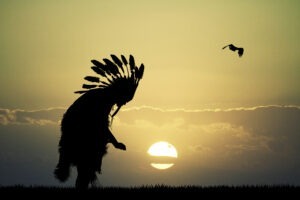
Background
I write what I call Heritage Fiction—novels about my ancestors. My interests lie in history, genealogy, and finding the truth. Although I write fiction, I use as many facts as I can to formulate my stories. The first novel I published, The Pulse of His Soul, was about Reverend John Lothropp (1584-1653), an Anglican minister in England during a tumultuous period when citizens of the kingdom were forced to attend the Church of England and no other. It was a time when people risked prison, torture, and death by defying the Church’s rigid laws about attendance and religious beliefs. One step out of line might find a person branded a heretic, causing arrest and prosecution before the dreaded Star Chamber at the royal Palace of Westminster. This is what happened to Reverend Lothropp, who came up against the formidable Archbishop William Laud.
With this background of research in 17th century Britain, I have written a three-book series about another Englishman of the same period. Thomas Savage sailed to the New World in 1608 when he was thirteen on the first supply ship bringing much needed food and supplies to British settlers in Jamestown. Savage had been in Virginia only two weeks before Captains John Smith and Christopher Newport traded him to the Native American Pamunkey Tribe to learn their language and culture. Savage became an accomplished interpreter for Jamestown and Powhatan leaders. He lived with the mamanatowick (emperor) Chief Powhatan for over two and a half years, becoming friends with Pocahontas.
For the third book in the Jamestown series, I have researched Pocahontas’s visit to England (1616-1617) and subsequently investigated the writings of Reverend Samuel Purchas, who interviewed the Powhatan Priest Tomocomo who had traveled to England with Pocahontas. Reverend Purchas found an interest in the religion of the Eastern Woodland Indians (also known as Powhatans). The Powhatans are sometimes referred to as Algonquians because of the Algonquian language they spoke and their common culture with tribes along the Eastern coast as far north as present-day Canada, east of the Rocky Mountains.
It appears Priest Tomocomo knew only some of the English language and had present for the interview the interpreter Thomas Savage, who Purchas refers to as “Dale’s interpreter.” Sir Thomas Dale had been the acting governor of Jamestown (March 1614 to April 1616) and came to England with Pocahontas’s group. He was the commander over Thomas Savage, who it appears served an indentured period for the Jamestown leaders from 1610-1617, after his years with the Pamunkeys. But Sir Dale was not present when Reverend Purchas interviewed Priest Tomocomo. Pocahontas was not present either, but her English husband John Rolfe was. The interview was held in the home of Doctor Theodore Goldstone, who lived near the Belle Savage Inn where Pocahontas and her group resided many months in London. I am not aware if there were others present at the interview.
The Powhatans did not have a written language when the Europeans settled on their lands in the early 1600s. Subsequently, records of the Jamestown Settlement were biased toward the British experience, religion, and peoples. Even if self-pride or imperialism was not recognized, an Englishman knew not to champion a common spiritual practice between the Church of England and Powhatan religion. He would be foolish to voice Powhatan religious leanings or questions because it would be considered heretical and he could be horribly punished with the threats of imprisonment, torture, or death (as John Lothropp was).
No one knows how much indoctrination took place for those who grew up in Britain during this time of Protestant Reformation. From what I have read, it appears an Englishperson would stand by his religion to the point of ignorantly referring to the Native Americans as “savages” and “heathens” because they did not believe as the Anglicans did. This was not a time of freedom of religion or speech. Quite the opposite.
Wanting to be fair-minded with my Jamestown stories (partially because in the end Thomas Savage chose to live the rest of his life with the Native Americans), I also read contemporary anthropological research about the Powhatan culture, trying to determine what was fact and fiction. Not an easy task, to be sure. Some academics could only guess at what the Powhatans truly believed when it came to their one supreme god, Ahone, or their devil god (as the English called him) Okeeus. (Alternate spellings: Okeus, Okee, Oke, Oki.)
Okeeus is a confusing fellow. The Powhatans (according to the English!) believed Okeeus could bring a drought, cause crop failures, disease, death, and basically anything bad. He is associated with war. The Powhatan priests would try to intercede by appeasing Okeeus with supplications of prayers and offerings of tobacco, deer suet, blood, precious beads, and other valuables. Some of these offerings were made on altar stones. Not appeasing Okeeus invited punishment.
But then there’s the other beliefs about Okeeus to whom temples were dedicated. He kept a close watch on the doings of men and could be found in the air, thunder, and storms.
The priests who served Chief Powhatan were considered wise and a conduit to a greater being who gave direction through ambiguous conversation, dreams, or deceased ancestors. Chief Powhatan would not go against what his priest told him to do in any given matter.
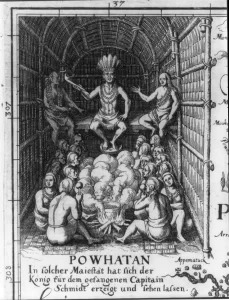
To the Point – The Interview
Below is part of the original interview between Reverend Samuel Purchas and the Powhatan Priest Tomocomo.
Of their [Powhatans] opinions and ceremonies in religion, who fitter to be heard than a Virginian?—an experienced man and counselor to Opochancanough [sp], their king and governor in Powhatan’s absence. Such is Tomocomo, at this present in England, sent hither to observe and bring news of our king and country to his nation. Some others which have been here in former times being more silly, which having seen little else than this city, have reported much of the houses and men, but thought we had small store of corn or trees, the Virginians imagining that our men came into their country for supply of these defects. This man [Tomocomo], therefore, being landed in the west parts, found cause of admiration at our plenty in these kinds, and, as some have reported, began to tell [tally?] both men and trees till his arithmetic failed. For their numb’ring beyond an hundred is imperfect and somewhat confused. Of him (Sir Thomas Dale’s man being our interpreter) I learned that their Okeeus doth often appear to them in his house or temple. The manner of which apparition is thus:
First, four of their priests, or sacred persons, of which he [Tomocomo] said he was one, go into the house, and by certain words of a strange language—which he repeated very roundly in my hearing, but the interpreter understood not a word, nor do the common people—call or conjure this Okeeus, who appeareth to them out of the air; thence coming into the house, and walking up and down with strange words and gestures, causeth eight more of the principal persons to be called in; all which twelve standing round about him, he prescribes to them what he would have done.
Of him they depend in all their proceedings, if it be but in a hunting journey, who by winds or other awful tokens of his presence holds them in a superstitious both fear and confidence. His apparition is in form of a personable Virginian, with a long black lock on the left side hanging down near to the foot…this Virginian so admiring this rite, that in arguing about religion he [Tomocomo] objected to our god this defect that he [God] had not taught us so to wear our hair. After that he [Okeus?] hath stayed with his twelve so long as he thinks fit, he departeth up into the air whence he came. Tomocomo averred that this was he which made heaven and earth; had taught them to plant so many kinds of corn; was the author of their good; had prophesied to them [Powhatans?] before of our men’s [the English] coming; knew all our country; whom he made acquainted [known to Tomocomo?] with his coming hither [to England?], and told him that within so many months he would return. But the devil, or Okeeus, answered that it would be so many more. Neither at his return must he go into that house [temple] till Okeeus shall call him. He [Tomocomo] is very zealous in his superstition and will hear no persuasions to the truth, bidding us teach the boys and girls which were brought over from thence [children in Pocahontas’s retinue], he being too old now to learn. Being asked what became of the souls of dead men, he [Tomocomo] pointed up to heaven; but of wicked men that they hung between heaven and earth.
~As recorded in Jamestown Narratives: Eyewitness Accounts of the Virginia Colony, The First Decade 1607-1617, compiled and edited by Edward Wright Haile, pp 880-884. Haile’s references Purchas His Pilgrimage or Relations of the World 1617:954, 1626:844, and Hakluytus Posthumus or, Purchas His Pilgrims 1625:1774 (Vol 19, pp 118-119).
Breaking it Down
How much did Reverend Purchas understand of what Priest Tomocomo said? Was he writing as Priest Tomocomo spoke, or did he write it down that evening after everyone left, or at some other time? Because that could make a difference. Did Reverend Purchas assume Priest Tomocomo was speaking about Okeeus when he wasn’t?
Perhaps more importantly, was it a coincidence that Priest Tomocomo spoke of the “he” who left his twelve by departing up in the air wence he came (which seems to mean he descended in like manner), then listed the other attributes of this “he” as:
This was he which made heaven and earth
Had taught them to plant so many kinds of corn [crops?]
Was the author of their good
Had prophesied to them before of our men’s [the English] coming
Knew all our country [England]
Whom he made acquainted with his coming hither [He will return?]
And told him that within so many months he would return. But the devil, or Okeeus, answered that it would be so many more. Neither at his return must he go into that house [temple?] till Okeeus shall call him.
If I’m following, someone will be returning and not allowed in the house or temple until Okeeus calls him.
Does Reverend Purchas interchange Okeeus and Ahone?
It seems suspect that Priest Tomocomo has a story about a man leaving his twelve and ascending into the air. And that same man is the one who has attributes like Christ.
In the sentence After that he [Okeus?] hath stayed with his twelve so long as he thinks fit, he departeth up into the air whence he came, the “After that he…” looks to have been tacked on to a paragraph that it doesn’t belong to. So, I asked myself, “after what?” There appears to be something missing here. I am certain Reverend Purchas does not follow the English rule of grammar that a pronoun following a proper name refers back to the last proper name given. For this reason, his writing is confusing. A few commas would have helped too!
Did the Powhatans have Jewish or Christian ancestors to have knowledge about the history of Christ, but the devil corrupted it, selling himself as the man (Christ) who had come to them earlier? We’ve heard it said that the devil is the great pretender. And although the Purchas interview is perhaps hard to understand and sometimes confusing, I think there’s enough there to try and figure it out.
If Priest Tomocomo was speaking of Christ, why did he not refer to him as the son of God or of some kind of relation to God/Ahone? From what I’ve read, the relationship between Ahone and Okeeus was never made clear, or the British didn’t think to write it down.
It appears Priest Tomocomo had a sacred language used in prayers in the Powhatan temple, which he recited for the group present. Even the interpreter Thomas Savage, who was fluent in Powhatan, did not understand what he said.
When Priest Tomocomo speaks of the twelve and the “man” who left by disappearing into the air, why does not anyone in the room, all being Anglican, see a correlation to the Ascension of Christ? Would they consider it sacrilege or heretical to broach that subject? I think so, considering the religious dogma of the time.
Or was Priest Tomocomo saying that in their temple, they (priests, him included) gathered with four and then eight other priests joining them, making twelve. Were they reenacting something honorable or wicked? And what was the root of that reenactment?
Being asked what became of the souls of dead men, Priest Tomocomo pointed up to heaven, showing that the Powhatans had a belief in a “heaven” above. But of wicked men, the Powhatans believed they “hung between heaven and earth,” which sounds very much like a spirit prison.
Reverend Purchas challenged Priest Tomocomo to abandon his beliefs and become Christian as Pocahontas had. Priest Tomocomo answered that he was too old to do that, but they (Reverend Purchas and others) were welcome to teach the children who had come to England with Pocahontas. No one is sure who these children were, but I suspect they were Native children who had been captured years before when English soldiers raided and plundered villages, killing the Native peoples of Virginia. These children were placed with Reverend Whitaker (the same man who helped in Pocahontas’s conversion to Christianity after her kidnapping) in Rocke Hall in Henricus, a town upriver from Jamestown, now known as Farrar’s Island. The children were taught not just Christianity but also the English language and academic subjects. Sir Dale had hoped to one day open a university for them and others, but a second war with the Powhatans foiled his plans.
The interview between Reverend Purchas and Priest Tomocomo is not printed in entirety here. Priest Tomocomo had also explained the huskanaw ceremony for teenage boys and more about the hair style of Powhatan men. He had also said the Powhatans “hold it a disgrace to fear death, and therefore when they must die do it resolutely.”
Additional Information of Interest
As a practice, the Powhatans took on a new name when something of great meaning changed their life course, or perhaps for other reasons unknown. Sometimes this new name was kept secret among the tribe members because if their enemies discovered the new name, their life could be at risk. There are dozens of examples, but to name a couple: when Pocahontas became a woman, she took on the secret name Matoaka, and when she was baptized Christian, she became Rebecca and could then share the name Matoaka because it was no longer secret or meaningful. Priest Tomocomo was known as Uttamatomakin before he made the great voyage to England at the request of his paramount chief.
Other common values and beliefs of the Powhatan, Jew, and Christian:
marriage between a husband and a wife (although chiefs could have multiple wives)laws, courts, and punishments for such crimes as murder, adultery, and theftfasting when praying for a needgiving sacrifice at meals, offering part of the first fruits or animals to their god and then to their ruler before partaking themselvespraying at mealtimesbelieving in an afterlife and heavenly place to livehad temples which the English knew little about because of the holiness of the buildinghad a strong belief in their deceased ancestors guiding their lives, inviting them into their prayer circles.Unlike the English, for the most part, the Powhatans allowed others to have their own religious beliefs. They did not have an organized church. Not all tribes agreed on the creation story, but they all did have a creation story and were very interested in the Christian creation story. John Rolfe wrote that the Natives were inconsistent in stating religious beliefs, “one denying that which another affirmeth.” One chief had asked the English to pray for rain because his gods would not send him any.
How much did the Natives and English Settlers have in common? How did the English misunderstand—and have we misunderstood—those people who were already here when the Anglicans established the Virginia Colony? We may never completely know. If only the Powhatans had left a written record.
October 13, 2023
What was The Peace of Pocahontas?
When the English first established Jamestown, Virginia in 1607, their relationships with the Indigenous Peoples (sometimes called ‘the Powhatans’ after Chief Powhatan, Pocahontas’s father) was precarious. Powhatan and the English settlers regarded each other with suspicion. Eventually, the two groups had inevitable conflicts and warred from 1610-1614. A lull in the fighting occurred 1614-1622 and was called The Peace of Pocahontas because the marriage of Pocahontas to an Englishman, John Rolfe, created a new concept of “getting along.” Powhatan and Deputy Governor Dale agreed to the marriage ending the conflict.
Interracial marriages in 1614 were extremely rare among Europeans when John’s and Pocahontas’s marriage was sanctioned by the Anglican Church. Their marriage was big news in both the old and new worlds. Rolfe wrote in his letter to Dale that “all the world may truly say: This is the work of God, and it is marvelous to our eyes” (Spelling corrected).
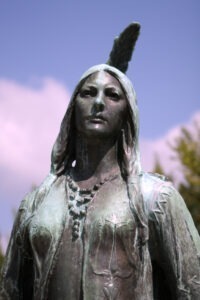 Pocahontas memorial in Jamestown
Pocahontas memorial in JamestownJohn Rolfe, the man who married Pocahontas (no, it wasn’t Captain John Smith, the love interest in Disney and other movies…Pocahontas was only eleven when Smith came on the scene) was so friendly it was made comment on by contemporaries in historical records. Rolfe is often remembered for the successful strain of Spanish tobacco he grew in Virginia, which became the commodity that made fortunes for the growers along the James River. But in Rolfe’s written letter to Sir Dale before Pocahontas’s baptism, he stated that his love for her was so strong that he worried if marrying her (a nonbeliever in Christ) was acceptable to his Christian beliefs. He said he prayed continually for the answer, and it eventually came to him from God that he was to teach her of Christ.
I believe Pocahontas to have been someone exceptional for her time. When writing my book, The Peace of Pocahontas, I read as many seventeenth-century English writings as I could find but considered them dubious and sometimes controversial. Claiming the story of Pocahontas as presented in English records as “historical fact” makes me uncomfortable. Instead, I have presented in my book a version of what could have happened as relating to those English records and to the Powhatan peoples’ religion, lifestyles, and civilization as far as historians understand. The Powhatans did not have a written record in the 17th century, so they have been overwhelmingly underrepresented.
 Pocahontas in England
Pocahontas in EnglandBecause I write historical fiction using as many facts as I can gather, I’m always reminded of how much we don’t know about past events. We usually don’t realize how people felt, the desires of their hearts, what they accomplished, or how their personalities and experiences drove them to make decisions. Looking for these aspects of a person is what motivates my research and creates how my stories are written.
When it comes to Pocahontas’s conversion to Christianity, there is of course no way I can know her heart and spiritual experiences with God. But it appears she converted to Christianity of her own accord through teachings by Reverend Whitaker and John Rolfe. Judging from Rolfe’s own passionate writings, he was a devout Christian and desired Pocahontas to have the same beliefs. It was the goal of many English people to bring Protestant Christianity to the Natives.
My greatest surprise while researching the book The Peace of Pocahontas was realizing after she was kidnapped, she was taken to Rocke Hall in Henricus where a Christian school had already been established for the Natives. Set up by Reverend Alexander Whitaker and Sir Thomas Dale, its purpose was to educate children in English ways and convert them to Christianity. I had no idea the concept of a Christian School for Natives had been devised so early in American history. Sir Dale had also planned a university for the Native boys, choosing the site where it would be built, but it never came to fruition. There have been many things done in the name of Christianity—wrong and right—and these schools throughout history were both evil and good. I can’t even try to unwind all the intricacies of why some took advantage of children while others did not. Or why some people thought they could force Christianity on another.
Pocahontas was and still is a fascinating woman. In all of history, can we find a young girl who played such an important part in a civilization? Pocahontas’s influence was far-reaching in the foundational history of the United States. Why did her father Powhatan allow his eleven-year-old daughter to help the original settlers? I suspect he preferred peaceful relations in the beginning and let his daughter play the part of ambassador. The settlers probably would have perished if not for the gifts of food she brought them. But why Pocahontas as ambassador? Did her father have insight into something we do not? Did he, and subsequently, Pocahontas believe in her objective for a greater peace? I believe all of us have a specific purpose(s) in life, and it doesn’t need to be on a grand scheme to be meaningful. God uses all people to achieve His purposes. Those who have clarity to know their purpose and have strength and courage to fulfill it usually do so at great sacrifice. That, I believe, is the story of Pocahontas.
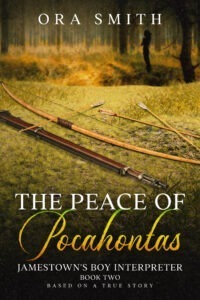 The Peace of Pocahontas novel available on Amazon
The Peace of Pocahontas novel available on Amazon

